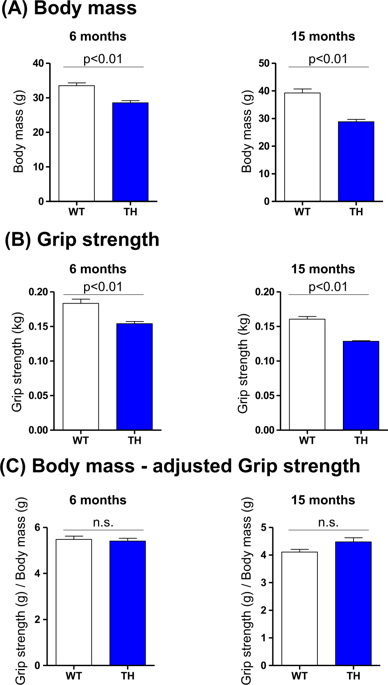当前位置:
X-MOL 学术
›
Hypertens. Res.
›
论文详情
Our official English website, www.x-mol.net, welcomes your
feedback! (Note: you will need to create a separate account there.)
Different effects of the deletion of angiotensin converting enzyme 2 and chronic activation of the renin-angiotensin system on muscle weakness in middle-aged mice
Hypertension Research ( IF 4.3 ) Pub Date : 2019-12-19 , DOI: 10.1038/s41440-019-0375-7 Hikari Takeshita 1 , Koichi Yamamoto 1 , Masaki Mogi 2 , Satoko Nozato 1 , Masatsugu Horiuchi 3 , Hiromi Rakugi 1
Hypertension Research ( IF 4.3 ) Pub Date : 2019-12-19 , DOI: 10.1038/s41440-019-0375-7 Hikari Takeshita 1 , Koichi Yamamoto 1 , Masaki Mogi 2 , Satoko Nozato 1 , Masatsugu Horiuchi 3 , Hiromi Rakugi 1
Affiliation

|
Inhibition of the renin-angiotensin system (RAS) has been shown to alleviate muscle atrophy both under pathological conditions and during physiological aging. We recently reported that the deletion of angiotensin converting enzyme 2 (ACE2), which converts Angiotensin II to Angiotensin-(1–7) in mice, leads to the early manifestation of aging-associated muscle weakness along with the increased expression of p16 INK4a , a senescence-associated gene, and increased central nuclei in the tibialis anterior (TA) muscle in middle age. As ACE2 is multifunctional and functions beyond its role in the RAS, we investigated whether activation of the RAS primarily contributes to muscle weakness in ACE2 knockout (KO) mice by comparing these mice to Tsukuba hypertensive (TH) mice that overproduce human angiotensin II. The grip strength of young (6 months) and middle-aged (15 months) TH mice was consistently lower than that of wild-type mice at the same ages. Middle-aged TH mice were continuously lean with extremely reduced adiposity. Central nuclei in the gastrocnemius (GM) muscle were increased in ACE2KO mice, while no apparent morphological change was observed in the GM muscles of TH mice. Increased expression of p16 INK4a along with alterations in the expression of several sarcopenia-associated genes were observed in the GM muscles of ACE2KO mice but not TH mice. These findings suggest that chronic overactivation of the RAS does not primarily contribute to the early aging phenotypes of skeletal muscle in ACE2KO mice.
中文翻译:

血管紧张素转化酶2缺失与肾素-血管紧张素系统慢性激活对中年小鼠肌无力的不同影响
肾素-血管紧张素系统 (RAS) 的抑制已被证明可以缓解病理条件下和生理老化期间的肌肉萎缩。我们最近报道了血管紧张素转化酶 2 (ACE2) 的缺失,该酶在小鼠体内将血管紧张素 II 转化为血管紧张素-(1-7),导致衰老相关肌肉无力的早期表现以及 p16 INK4a 的表达增加,衰老相关基因,中年时胫骨前肌 (TA) 中的中央核增加。由于 ACE2 是多功能的,其功能超出了其在 RAS 中的作用,我们通过将这些小鼠与过度产生人血管紧张素 II 的筑波高血压 (TH) 小鼠进行比较,研究了 RAS 的激活是否主要导致 ACE2 敲除 (KO) 小鼠的肌肉无力。年轻(6 个月)和中年(15 个月)TH 小鼠的握力始终低于相同年龄的野生型小鼠。中年 TH 小鼠持续瘦弱,肥胖程度极低。ACE2KO小鼠的腓肠肌(GM)中枢核增加,而在TH小鼠的GM肌肉中未观察到明显的形态变化。在 ACE2KO 小鼠而非 TH 小鼠的 GM 肌肉中观察到 p16 INK4a 表达增加以及几种肌肉减少症相关基因表达的改变。这些发现表明,RAS 的慢性过度激活并不主要导致 ACE2KO 小鼠骨骼肌的早期衰老表型。中年 TH 小鼠持续瘦弱,肥胖程度极低。ACE2KO小鼠的腓肠肌(GM)中枢核增加,而在TH小鼠的GM肌肉中未观察到明显的形态变化。在 ACE2KO 小鼠而非 TH 小鼠的 GM 肌肉中观察到 p16 INK4a 表达增加以及几种肌肉减少症相关基因表达的改变。这些发现表明,RAS 的慢性过度激活并不主要导致 ACE2KO 小鼠骨骼肌的早期衰老表型。中年 TH 小鼠持续瘦弱,肥胖程度极低。ACE2KO小鼠的腓肠肌(GM)中枢核增加,而在TH小鼠的GM肌肉中未观察到明显的形态变化。在 ACE2KO 小鼠而非 TH 小鼠的 GM 肌肉中观察到 p16 INK4a 表达增加以及几种肌肉减少症相关基因表达的改变。这些发现表明,RAS 的慢性过度激活并不主要导致 ACE2KO 小鼠骨骼肌的早期衰老表型。在 ACE2KO 小鼠而非 TH 小鼠的 GM 肌肉中观察到 p16 INK4a 表达增加以及几种肌肉减少症相关基因表达的改变。这些发现表明,RAS 的慢性过度激活并不主要导致 ACE2KO 小鼠骨骼肌的早期衰老表型。在 ACE2KO 小鼠而非 TH 小鼠的 GM 肌肉中观察到 p16 INK4a 表达增加以及几种肌肉减少症相关基因表达的改变。这些发现表明,RAS 的慢性过度激活并不主要导致 ACE2KO 小鼠骨骼肌的早期衰老表型。
更新日期:2019-12-19
中文翻译:

血管紧张素转化酶2缺失与肾素-血管紧张素系统慢性激活对中年小鼠肌无力的不同影响
肾素-血管紧张素系统 (RAS) 的抑制已被证明可以缓解病理条件下和生理老化期间的肌肉萎缩。我们最近报道了血管紧张素转化酶 2 (ACE2) 的缺失,该酶在小鼠体内将血管紧张素 II 转化为血管紧张素-(1-7),导致衰老相关肌肉无力的早期表现以及 p16 INK4a 的表达增加,衰老相关基因,中年时胫骨前肌 (TA) 中的中央核增加。由于 ACE2 是多功能的,其功能超出了其在 RAS 中的作用,我们通过将这些小鼠与过度产生人血管紧张素 II 的筑波高血压 (TH) 小鼠进行比较,研究了 RAS 的激活是否主要导致 ACE2 敲除 (KO) 小鼠的肌肉无力。年轻(6 个月)和中年(15 个月)TH 小鼠的握力始终低于相同年龄的野生型小鼠。中年 TH 小鼠持续瘦弱,肥胖程度极低。ACE2KO小鼠的腓肠肌(GM)中枢核增加,而在TH小鼠的GM肌肉中未观察到明显的形态变化。在 ACE2KO 小鼠而非 TH 小鼠的 GM 肌肉中观察到 p16 INK4a 表达增加以及几种肌肉减少症相关基因表达的改变。这些发现表明,RAS 的慢性过度激活并不主要导致 ACE2KO 小鼠骨骼肌的早期衰老表型。中年 TH 小鼠持续瘦弱,肥胖程度极低。ACE2KO小鼠的腓肠肌(GM)中枢核增加,而在TH小鼠的GM肌肉中未观察到明显的形态变化。在 ACE2KO 小鼠而非 TH 小鼠的 GM 肌肉中观察到 p16 INK4a 表达增加以及几种肌肉减少症相关基因表达的改变。这些发现表明,RAS 的慢性过度激活并不主要导致 ACE2KO 小鼠骨骼肌的早期衰老表型。中年 TH 小鼠持续瘦弱,肥胖程度极低。ACE2KO小鼠的腓肠肌(GM)中枢核增加,而在TH小鼠的GM肌肉中未观察到明显的形态变化。在 ACE2KO 小鼠而非 TH 小鼠的 GM 肌肉中观察到 p16 INK4a 表达增加以及几种肌肉减少症相关基因表达的改变。这些发现表明,RAS 的慢性过度激活并不主要导致 ACE2KO 小鼠骨骼肌的早期衰老表型。在 ACE2KO 小鼠而非 TH 小鼠的 GM 肌肉中观察到 p16 INK4a 表达增加以及几种肌肉减少症相关基因表达的改变。这些发现表明,RAS 的慢性过度激活并不主要导致 ACE2KO 小鼠骨骼肌的早期衰老表型。在 ACE2KO 小鼠而非 TH 小鼠的 GM 肌肉中观察到 p16 INK4a 表达增加以及几种肌肉减少症相关基因表达的改变。这些发现表明,RAS 的慢性过度激活并不主要导致 ACE2KO 小鼠骨骼肌的早期衰老表型。











































 京公网安备 11010802027423号
京公网安备 11010802027423号